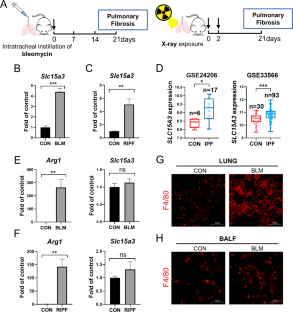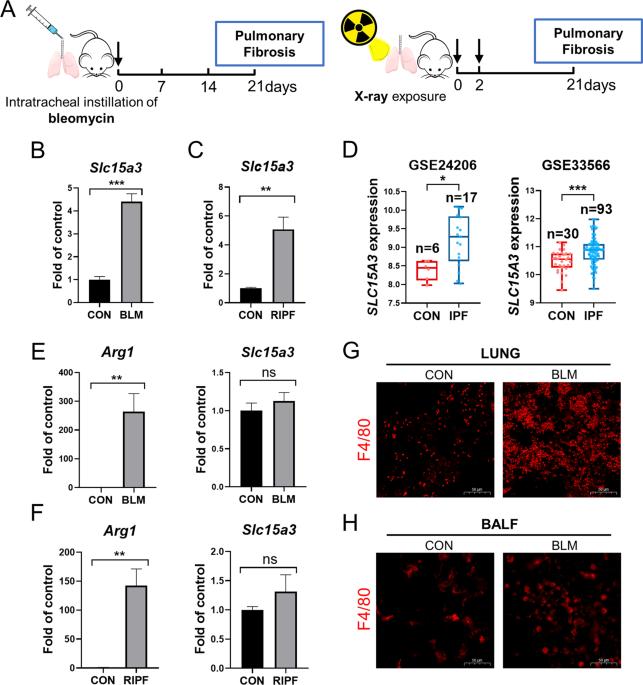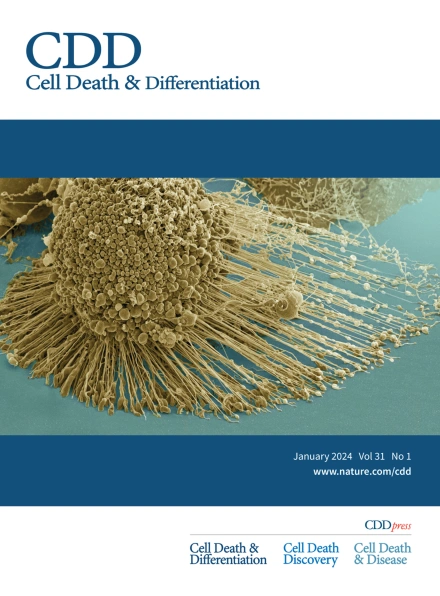SLC15A3 通过调节巨噬细胞氧化应激,在肺纤维化中发挥着至关重要的作用。
IF 15.4
1区 生物学
Q1 BIOCHEMISTRY & MOLECULAR BIOLOGY
引用次数: 0
摘要
特发性肺纤维化(IPF)是一种致命且不可逆的疾病,几乎没有有效的治疗方法。由于直接暴露于空气中,肺泡巨噬细胞(AMs)从最初阶段就参与了 IPF 的发展,并对外部氧化损伤(肺纤维化的主要诱因)做出反应。AMs中的氧化应激在促进纤维化发展中起着不可或缺的作用。寡肽组氨酸转运体 SLC15A3 主要表达于巨噬细胞的溶酶体膜上,在肺中高度表达,已被证实参与先天性免疫和抗病毒信号通路。本研究表明,在博莱霉素(BLM)或辐射诱导的肺纤维化过程中,巨噬细胞的募集诱导了肺中SLC15A3的增加,而SLC15A3的缺乏能保护小鼠免于肺纤维化并维持肺微环境的平衡。从机理上讲,SLC15A3的缺乏可抵抗巨噬细胞中的氧化应激,SLC15A3与支架蛋白p62相互作用,调节其表达和磷酸化活化,从而调节与活性氧(ROS)产生有关的p62-核因子红细胞2相关因子2(NRF2)抗氧化应激通路蛋白。总之,我们的数据提供了靶向 SLC15A3 调节巨噬细胞氧化应激的新机制,支持抑制或沉默 SLC15A3 在预防和治疗肺纤维化方面的治疗潜力。本文章由计算机程序翻译,如有差异,请以英文原文为准。


SLC15A3 plays a crucial role in pulmonary fibrosis by regulating macrophage oxidative stress
Idiopathic pulmonary fibrosis (IPF) is a fatal and irreversible disease with few effective treatments. Alveolar macrophages (AMs) are involved in the development of IPF from the initial stages due to direct exposure to air and respond to external oxidative damage (a major inducement of pulmonary fibrosis). Oxidative stress in AMs plays an indispensable role in promoting fibrosis development. The oligopeptide histidine transporter SLC15A3, mainly expressed on the lysosomal membrane of macrophages and highly expressed in the lung, has proved to be involved in innate immune and antiviral signaling pathways. In this study, we demonstrated that during bleomycin (BLM)- or radiation-induced pulmonary fibrosis, the recruitment of macrophages induced an increase of SLC15A3 in the lung, and the deficiency of SLC15A3 protected mice from pulmonary fibrosis and maintained the homeostasis of the pulmonary microenvironment. Mechanistically, deficiency of SLC15A3 resisted oxidative stress in macrophages, and SLC15A3 interacted with the scaffold protein p62 to regulate its expression and phosphorylation activation, thereby regulating p62-nuclear factor erythroid 2-related factor 2 (NRF2) antioxidant stress pathway protein, which is related to the production of reactive oxygen species (ROS). Overall, our data provided a novel mechanism for targeting SLC15A3 to regulate oxidative stress in macrophages, supporting the therapeutic potential of inhibiting or silencing SLC15A3 for the precautions and treatment of pulmonary fibrosis.
求助全文
通过发布文献求助,成功后即可免费获取论文全文。
去求助
来源期刊

Cell Death and Differentiation
生物-生化与分子生物学
CiteScore
24.70
自引率
1.60%
发文量
181
审稿时长
3 months
期刊介绍:
Mission, vision and values of Cell Death & Differentiation:
To devote itself to scientific excellence in the field of cell biology, molecular biology, and biochemistry of cell death and disease.
To provide a unified forum for scientists and clinical researchers
It is committed to the rapid publication of high quality original papers relating to these subjects, together with topical, usually solicited, reviews, meeting reports, editorial correspondence and occasional commentaries on controversial and scientifically informative issues.
 求助内容:
求助内容: 应助结果提醒方式:
应助结果提醒方式:


